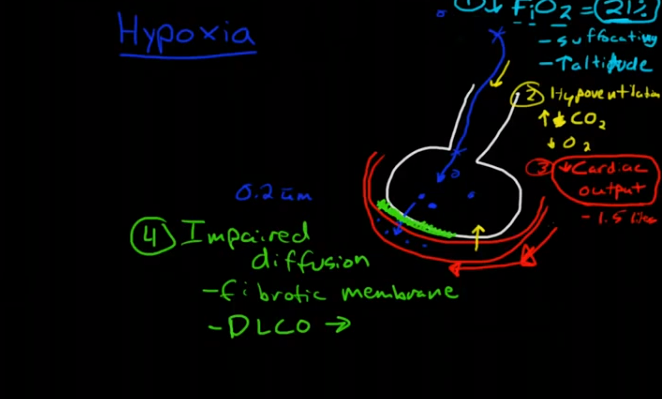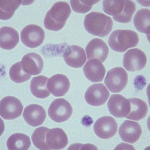Hypoxia is an abnormal condition caused due to the deprivation of sufficient oxygen supply to a part of the body or to the body as a whole. The former is referred to as tissue hypoxia, while the latter is known as generalized hypoxia. It may also be noted that the concentration of oxygen in the arteries may also differ as part of the normal body physiology, such as during times of vigorous physical exercise.
Hypoxia vs Hypoxemia
Hypoxia is different from Hypoxemia, while the latter means decreased quantity of oxygen in the blood, hypoxia is reduced oxygen supply to the tissues.
A hypoxic state may result when there is a mismatch between the demand for oxygen at the cellular level and the actual supply of oxygen. Hypoxia which involves a complete lack of oxygen supply is known as anoxia.It is important to note that hypoxia is not the same as hypoxemia. The latter is a state wherein the concentration of oxygen inside the arterial blood is unusually low. In fact hypoxemia is one of the causes of hypoxia, as in the case of hypoxemic hypoxia.
Symptoms of hypoxia
The signs and symptoms of generalized hypoxia are dependent on the speed of onset as well as the severity level. Individuals affected by altitude sickness generally experience slow onset of hypoxia. In such cases the patient may elicit the below listed symptoms:
- Fatigue
- Headache
- Impaired judgment,
- Shortness of breath
- Confusion or difficulty in paying attention
- Sensations of euphoria
- Loss of memory
- Nausea
- Compromised coordination
Severe cases of hypoxia are characterized by an extremely swift onset. It may result in the following signs and symptoms:
- Seizures
- Bluish discoloration of the skin
- Coma
- Severe headaches
- Changes in the consciousness levels
- Priapism
- Severe breathlessness
- Fatality
Causes of hypoxia
- Healthy individuals can develop generalized hypoxia when they are climbing to a higher altitude. This is especially applicable for people who are not used to living at higher altitudes. The condition is generally preceded by altitude sickness which can then lead to life-threatening complications such as HACE or high altitude cerebral edema, and HAPE or high altitude pulmonary edema.
- Health people can also develop hypoxia when breathing in a combination of gases that has reduced oxygen content. For example, people who go for underwater diving adventures may experience hypoxia, particularly when using closed circuit re-breather gadgets that regulate the quantity of oxygen in the supplied air.
- Adventurists who are going to travel to higher altitudes often undergo intentional instances of non-damaging and mild hypoxia. It is a training method used by the athletes so as to adapt the body for radical altitude changes in the future.
Hypoxia Types
1. Hypoxic hypoxia refers to generalized hypoxia wherein the entire body is affected by insufficient oxygen supply. It is an indication of hypoxia that is caused due to decreased partial oxygen pressure in arterial blood. Hypoxic hypoxia may be caused due to:
- During recreational and intentional use of nitrous oxide; due to reduced partial pressure of oxygen in the atmosphere like that observed at higher altitudes; or due to accidental switch of oxygen in the respiratory mixture that are used in the altered atmosphere of a sewer.
- Insufficient pulmonary ventilation, as in the cases of a respiratory attack, or in COPD.
- Reduced concentration of oxygen in the blood due to presence of conditions like hypopnea or sleep apnea
- Decreased partial oxygen pressure in the lungs caused during the transfer from administered anesthesia to atmospheric air. It is called diffusion hypoxia or the Fink effect.
- Collapsed alveoli or ventilation blocks to the lung areas can result in shunts which stop the exchange of gases. Other causes include normal physiological shunts and normal anatomical shunts.
2. Histotoxic hypoxia is characterized by normal amounts of oxygen in the cells. However, the cells are not able to use the oxygen effectively because of disabled oxidative phosphorylation enzymes. Intake of excessive alcohol can cause this condition.
3. Hypemic hypoxia is characterized by the presence of normal arterial pressure of oxygen. However, the total content of oxygen in blood is low. It can be caused due to:
- Carbon monoxide poisoning which hinders the capability of hemoglobin to discharge the oxygen that it is carrying.
- The failure of blood to supply oxygen to relevant tissues
- The buildup of abnormal hemoglobin known as methaemoglobinaemia in the blood
4. Stagnant or ischemic hypoxia is characterized by the presence of local constraints in the supply of well-oxygenated blood. This results in inadequate supply of oxygen to that particular region.

Treatment of hypoxia
There are several ways to treat hypoxia and its symptoms. The treatment options are dependent on the severity of the condition. As hypoxia has a tendency to rapidly deteriorate in severity levels, it is essential to begin the treatment immediately after the diagnosis.
Most cases of hypoxia can be treated with crucial life-support measures, and medical equipment is not always necessary. It is also important to maintain the breathing rate in patients.
In case medical equipment is available, then the patient can be given intravenous fluids, as well as drugs that prevent elevated blood pressure and seizures.

